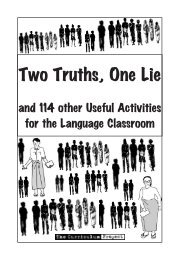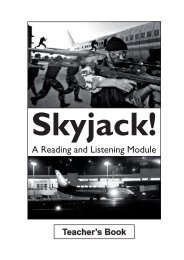Teacher's Guide - The Curriculum Project
Teacher's Guide - The Curriculum Project
Teacher's Guide - The Curriculum Project
- No tags were found...
Create successful ePaper yourself
Turn your PDF publications into a flip-book with our unique Google optimized e-Paper software.
Employment, etc. (cont’d)Burmese migrant workers in Mae SotPre teach: to fire (verb): to dismiss someone from their job; severely (adverb): badly; toprotest (verb): to argue against, object; unprecedented (adj): something which has neverhappened before; activist (noun): a person who uses direct action to try to change things;back-breaking (adj): very difficult, physically exhausting.Ask students to read the text. Give them about 10 minutes. <strong>The</strong>n elicit any wordsthat students don’t know. Ask if they can guess the meaning. If not, give them adictionary, or tell them the meaning.On Your Own1. Write the questions below on the board (but not the answers!). Give them about20 minutes to write their answers. <strong>The</strong>m put them into pairs and ask them to compareanswers and agree. <strong>The</strong>n elicit one answer in turn from a different pair and checkagreement with the rest of the class.a. Why were Burmese workers fired from the Nut Knitting Factory?Answer: <strong>The</strong>y were fired because they demanded better working conditions.b. What happened to the workers when they protested against unfair treatment?Answer: <strong>The</strong>y were severely beaten by gangs linked to the company.c. Why didn’t the workers believe they could win the court case?Answer: Because it was the first-ever legal case brought by Burmese workers in Thai courts.d. Why couldn’t the workers find employment in other factories during the court case?Answer: Other factories wouldn’t employ them because they were seen to be‘troublemakers’.e. Why was the victory so important?Answer: Because it will encourage other workers to fight for their rights in the Thai labourcourts.f. What kind of jobs do Burmese migrant workers often have to do in Thailand?Answer: Burmese migrant workers often have to do dirty, dangerous, back-breaking jobs.Groupwork2. Put the students into groups and ask them to think about the questions below,and write down their ideas.Why are Burmese migrant workers usually treated worse than Thai workers in Thailand?As they are not Thai citizens, Burmese migrant workers in Thailand have fewer rights than Thais, andthe rights they do have are rarely enforced by the legal system. For instance, the legal minimum wage inTak Province is 139 baht per day, with 25 baht per hour for overtime. However, research shows that mostBurmese workers in the province receive around 55 baht per day, with 7 baht per hour overtime.What are the economic advantages for Thai employers who treat Burmese migrant workersunfairly?By paying Burmese workers less, Thai employers are able to produce goods and services more cheaply,and therefore be more competitive in the market, and make more profit. Thai businesses are often competingwith other low-wage economies in South East Asia, such as China, Cambodia, Vietnam and Laos. Thaiemployers are aware that the Thai legal system will not systematically enforce the rights of Burmesemigrant workers.What do you think are the best ways to change the situation?Many Burmese migrant workers are pleased to have jobs in Thailand, despite the low wages. This isbecause there is very little employment in Burma, and the wages are even lower there. <strong>The</strong>y usually onlyprotest at their treatment if their employers refuse to pay them anything at all. Furthermore, if Thaiemployers are forced to pay the legal minimum wage to Burmese migrant workers, it might cause businessesto close, and workers to lose their jobs. <strong>The</strong>refore, the employment situation between Burmese workersand Thai employers is a delicate balance, and changes probably need to be gradual and carefullyconsidered.<strong>The</strong> <strong>Curriculum</strong> <strong>Project</strong> ECONOMICS: an introduction - Teacher’s <strong>Guide</strong>39













![[Eng] Nov 2012 DRAFT - The Curriculum Project](https://img.yumpu.com/45590859/1/184x260/eng-nov-2012-draft-the-curriculum-project.jpg?quality=85)


